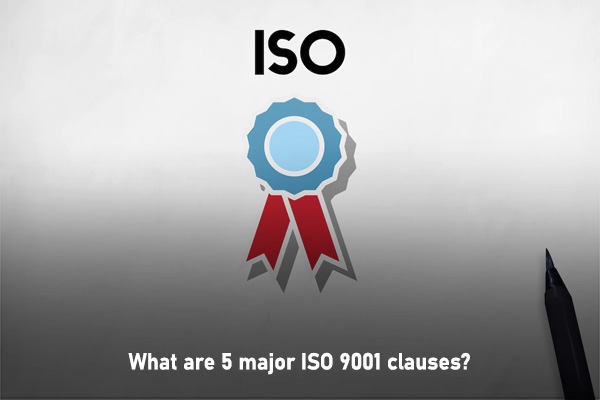What are 5 major ISO 9001 clauses?
If you are planning to implement a Quality Management System (QMS) in your organisation, you need to be familiar with the 10 clauses of ISO 9001. Clauses 0 to 3 are not mandatory for the implementation of the QMS, but contain descriptions of the relationship between different clauses.
Clause zero mentions the benefits of implementing the quality management principles, clause 1 to 3 contain the definitions of commonly used terms, so that the reader can better understand the standard. Clause 4 explains the context of the organisation, helping business owners understand what internal and external issues can influence the performance of the QMS and how the expectations of all relevant parties can be identified. The next five clauses are considered the “main,” or the “major” clauses of ISO 9001. Read further to learn more about the five major ISO 9001 clauses.

Clause 5: Leadership and commitment
This clause outlines the leadership requirements that the top management needs to demonstrate. This includes promoting a customer focus across the organisation, developing and standing by a quality policy that sets the organisation in alignment and determining responsibilities for the QMS. Clause 5.1.1 talks about the general commitment requirements and how the leadership must demonstrate their commitment through the allocation of adequate resources.
Clause 5.1.2 focuses on inculcating a customer-focused environment within the organisation. Clause 5.2 focuses on the establishment of the quality policy and how it should be adequately communicated across the organisation, specifying different types of communication channels that suit different organisations. Clause 5.3 focuses on organisational roles, responsibilities and authorities. You can find more information in the requirements of iso 9001 article.
Clause 6: Planning
Clause six presents the requirements for determining and working with risks that can negatively impact the quality of products or services, helping you set up appropriate quality objectives that align with your quality policy and the strategic direction of your organisation.
Clause 6.1 guides organisations on the actions that you need to take to address risks and opportunities, section 6.2 helps to create quality objectives and 6.3 helps to plan for upcoming changes. we talk about ISO 9001 PDCA before and examine its planning step.
Clause 7: Support
This section is diverse and includes requirements for the proper management of resources. Clause 7.1 focuses on resources such as general resources, people, infrastructure, environment for optimal operation of processes, monitoring and measuring resources and organisational knowledge. Clause 7.2 focuses on competence, 7.3 on awareness, 7.4 and communication and 7.5 on documented information including how to create, update and control all documented information.

Clause 8: Operation
This is one of the larger clauses of the standard and organisations have the liberty to exclude sections of the requirements that do not apply to the individual circumstance.
For example, organisations can choose to exclude design requirements if their company does not do design work. Instructions within this clause help organisations plan for their products or services, including determining how the product should be reviewed, designed, developed, purchased and how the best practices can be incorporated in the manufacturing operations.
This section contains seven sub-clauses, where 8.1 deals with operational planning and control, 8.2 with requirements for production services, 8.3 with design and development, 8.4 with control of externally provided processes, 8.5 with service version, 8.6 with the release of products or services and 8.7 with control of nonconforming outputs. ISO 9001 opreation is a major part of the iso 9001 consultancy procedure.
Clause 9: Performance evaluation
This section outlines the requirements that organisations can use to assess customer satisfaction, conduct internal audits and perform management reviews. This clause contains three sub-sections, where 9.1 provides the recommendations for monitoring, measurement, analysis and evaluation, 9.2 contains the recommendations for internal audits and 9.3 contains the requirements for management reviews.
Clause 10: Improvement
The last clause of ISO 9001 contains pertinent information about improving the QMS through continual improvement and corrective actions. This clause contains three subsections where 10.1 provides general requirements, 10.2 lists corrective actions for nonconformities and 10.3 outlines recommendations for continual improvement.

Differences between clauses of ISO 9001:2008 vs ISO 9001:2015
The first four clauses namely the introduction, scope, normative references and terms have remained the same in both the versions. Changes are visible from clause four, which was earlier known as the quality management system and is now available as the context of the organisation. Similarly, management responsibility has transformed into leadership planning, resource management into support, product realisation into operation and measurement, analysis and improvement into performance evaluation and improvement.
Note on ISO 9001 implementation
One of the biggest challenges in implementing the requirements of the standard is ensuring that the resultant policies, processes, procedures and records match with the needs of both the customers and the organisation, while simultaneously allowing room for improvement. Continuous improvement is one of the main reasons why organisations choose to implement a QMS, as it provides many long-term benefits for the company.
Hence, when creating the quality policies, objectives and procedures, remember to keep a “wiggle room,” so that you can make modifications in the future. Additionally, to reap the benefits of continuous improvement, it is also necessary to conduct regular evaluation in the form of internal audits. Hence, when implementing the clauses, remember to delegate responsibilities to appropriate individuals to periodically evaluate the efficiency, relevance and feasibility of all processes.
Supercharge Your Business
ISO certification gives your organisation a competitive edge. By helping you increase operational efficiency and overall product consistency, your business credibility and authority will soar to new heights.

